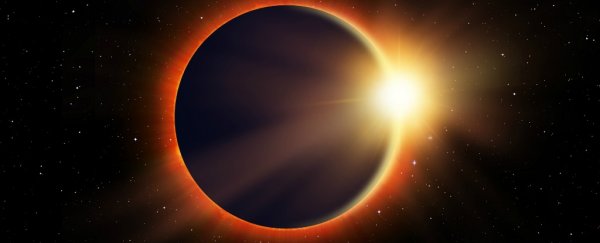Darkness is coming. At least, partial darkness, depending on where you live.
On Monday, August 21, people across the US will have the chance to see a total or partial eclipse. Only those in a 70 mile band will see the Sun fully blackened out by the Moon, but most of us will at least see some of what was once thought of as a celestial dragon devouring the Sun.
There are ways you can photograph the Great American Eclipse without damaging your camera or phone (or eyes), but if you do it wrong, you could permanently damage your devices.
Looking at the Sun with your naked eye can burn your retinas, even if that star we orbit is almost entirely covered by the Moon. That's why you need to wear protective glasses or use some other method to view the eclipse safely.
Damage can also can happen to most camera sensors if you point them directly at the Sun, especially if your camera has got a powerful lens on it.
Here's what you need to know to take a safe and high-quality shot.
Smartphone photos:
Remember - if you are staring at the eclipse with your naked eye, trying to line up the perfect shot, you could damage your vision.
There's some debate about whether a quick shot of the eclipse could do any harm to your phone's sensor, according to NASA, though they conclude it's probably fine.
If you're using an iPhone, you should be ok. According to Apple, it's ok to take a photo using your smartphone without a solar filter on the lens, since there's not enough magnification to let in the amount of light necessary to harm your lens or sensor (it should be essentially the same for other smartphones with comparable cameras).
It's a wide angle shot and the Sun or Moon only will fit in a smallish part of that image.
That's a great way to take a photo of you and your friends with the eclipse in the background. If you are going to try it, adjust your camera so it's not letting in too much light and blowing out your image. You could also put your phone on a tripod and record the scene.
But you won't be able to capture a full, massive eclipse image like those seen online with a wide angle lens you'd find on a phone. Try taking a photo of the Moon with your phone - that's about what you'll be able to see during the eclipse.
If you want to capture more of a shot, you'll need a telephoto attachment or zoom lens for your camera. The magnification effect will mean you also need a filter to protect your camera's sensor from being burned by the Sun.
DSLR and zoom lens users:
If you're taking a photo with a more traditional camera that has any sort of real zoom - even a point and shoot but especially a DSLR - you need some sort of solar filter to protect your lens from damage.
These can be obtained from your local photography store - it may be too late to find one on Amazon or other online retailers, though you can always check. A filter sheet or #14 welders glass in front of your camera can do the trick as well.
For specific details about the best settings to use, including recommended ISO, aperture, and shutter speed, there are excellent guides you can check out Nikon, Canon, and B&H Photo.
Remember to practice with your gear. You're only going to have a couple minutes to shoot, so you don't want to be fiddling with settings.
To really capture the Sun in the frame, you're going to need a zoom lens that's probably at least a 300mm lens, and you'll likely want an even more powerful zoom, between 500mm and 1000mm. Your flash is useless, so just keep that turned off.
Settings vary slightly depending on which moment of the eclipse you are trying to capture, but most experts recommend a low ISO (100 or maybe 200) and a fairly wide aperture.
Different shutter speeds should help you capture different moments - for more details, check the guides linked above.
If you're shooting within the totality band, don't forget to take the solar filter off your lens when the Sun is fully covered. At that point, you'll be shooting in dark conditions and will need a tripod to take stable shots.
Using a remote trigger for your shutter or a delay will also help you avoid camera shake. Make sure to replace the filter when you start to see beads of light appearing again.
Beyond that, have fun!
This article was originally published by Business Insider.
